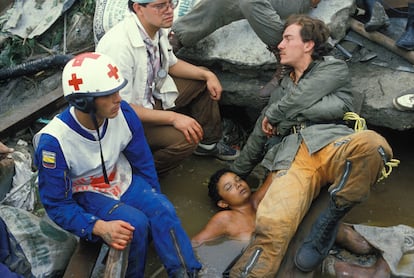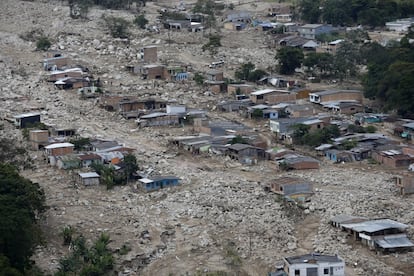
When Gloria Cortés started studying geology, she didn’t think about the huge volcano near her home in the Colombian city of Manizales. In early 1984, Nevado del Ruiz was a tourist destination enjoying the snows of the “Sleeping Lion” whose last eruptions occurred in the 16th and 19th centuries. She chose her career because an academic came to visit her chemistry class at school and talked about the world of fossils and oil and her upcoming travels. A year and a half later, on November 13, 1985, Mount Ruiz erupted, causing the largest natural disaster in Colombian history. He killed about 25,000 people, including Cortés’ best friend, and buried the town of Armero. This student and many of his classmates abandoned their interest in hydrocarbons and began studying volcanoes to prevent other tragedies.
Lewis’ first warning signal was an earthquake in December 1984, more than a century after the last eruption. Cortez said some climbers began warning teachers about noticeable changes on the snow-capped mountain peaks, such as yellowish gas, changes in the color of the snow, and loud noises. “We started receiving important visits from foreign geologists who told us we needed to start monitoring and create threat maps,” Cortes said in a video call from the Manizales Volcano Seismological Observatory, about 30 kilometers from the snowy peak. In July 1985, authorities installed four seismometers on the volcano. In September, the first eruption, although small and without magma, blanketed the city of Manizales in ash, raising concerns. A few weeks later, a map was released that identified the danger zone in which Armero was located.
There were major limitations. For example, the four installed sensors did not have telemetry systems to transmit information in real time. The seismic waves were recorded on paper, which had to be transported by road and highway to Manizales, some 50 kilometers away, to be analyzed. The transmitter was scheduled to arrive exactly one week before the eruption, but the committee in charge of it was “cancelled” due to another tragedy that shook Colombia in November 1985: the capture and retaking of the Palace of Justice. There weren’t enough experts either. “We didn’t even know the word ‘volcanology,'” Cortes recalls.
However, geologists claim that much was done within the limitations. “We had cutting-edge technology and pioneering people who worked early in the morning and for months on end, in a country that didn’t have the proper systems in place. It was frustrating to see that effort come to fruition,” he says. For her, the main problem was not scientific, but social. There was “no time” to convince local communities that the threat was real and that they should move. “The elders said, ‘This has never happened in my life, it will never happen again,’ without understanding that 80 years is nothing in terms of volcanic experience,” he comments.
When the volcano erupted at 9:08 p.m. On November 13, 1985, the only warning came from a journalist. At 10:30 p.m., he said on the radio that he had been warned by highland residents about an avalanche of mud and rocks coming down at full speed toward Armero, on the mountainside opposite Manizales. The rain hampered communications and few people heard. An hour later, more than 22,000 people out of a total population of 30,000 who lived in the city of Tolima were buried, and another 3,000 died in the neighboring province of Caldas. The Almerians never knew that 15 minutes was enough to go to the hills and save their lives.
after the tragedy
Geologists, Colombian or foreign, have studied the Almelo tragedy as a demonstration of the influence of snow-capped mountains. Lewis is located at 5,300 meters above sea level. “For volcanoes with ice and snow-covered summits, relatively small eruptions can generate catastrophic lahars,” concluded a paper published in 1990. Journal of Volcanology and Geothermal Research. The Nov. 13 eruption barely earned a 3 out of 8 on the Volcano Explosivity Index, but the interaction of hot material with the glacier produced large amounts of water. The current rushed down the river, sweeping away everything in its path. The eruption caused “the deadliest mudslide on record,” according to the article.

Colombia has begun to take volcanic risks seriously. There are 25 active volcanoes. Lina Marcela Castaño, coordinator of the Manizales Observatory, commented that Ruiz has gone from being “an object of admiration for its beauty” to a geological formation that requires monitoring. “Currently, we have 75 sensors. We measure not only earthquakes, but also gases, magnetic signals, acoustics and slope slopes,” he says in Manizales, where he is collaborating with Cortés. The observatory he directed was established in 1986, followed by an observatory in Pasto in 1989 and an observatory in Popayan in 1993. More than 100 experts study the history of the formation, interpret sensor data, and raise community awareness. They classify volcanoes into risk categories: green (normal), yellow (low), orange (medium), and red (high). There are currently 10 yellow ones and none of them are at the highest level.
Awareness of the need to heed warning signals and evacuate has also been strengthened, said the two geologists and colleague Julián Ceballos. One positive reference is the case of Mount Pinatubo in the Philippines, which had a level 5 eruption in 1991. Geologists said authorities showed videos of the 25,000 deaths in Almelo to persuade countless people at risk to evacuate. The eruption was the second most powerful of the 20th century, but only 847 people were killed, although some 200,000 people were evacuated. Another case is Nevado del Huila in Colombia, where several large mudflows occurred in 2007-2008. “Indigenous communities understand the impact and were key to evacuating around 6,000 people,” Ceballos said.

However, there are also challenges. One is that volcanic eruptions compete for community benefits with other more frequent phenomena such as floods, earthquakes, and landslides. If this phenomenon occurs every few decades or even centuries, it becomes even more difficult to convince the affected people to evacuate and lose their livelihoods. Similarly, the state must be persuaded every year that it needs to maintain funding for the observatory. “Fortunately we were able to do that this year, but we are always exposed to non-renewal,” said coordinator Castagno. “The last time we bought major equipment was in 2010. Only now, after 15 years, will we start updating our equipment,” he added.
Other catastrophes
Although not volcanoes, other pre-announced catastrophes have shocked Colombia in recent decades. In 2010, a landslide buried Grammarote in Norte de Santander. The work was slower than in Armero, taking two days, but all 3,300 residents were able to evacuate in time. No one was killed, but there was strong criticism because warnings that the town was in a dangerous area and should be relocated had been ignored for years. Seven years later, a series of rains suddenly triggered an avalanche of land in the city of Mocoa, endangering it from unstable mountains and river confluences. More than 330 people were killed and another 400 injured.

Julio Fierro, director of Colombia’s Geological Survey, acknowledged in a video call that there is a case for “history repeating itself.” He commented that scientific information was “not used” in Mocoa, noting that he is concerned about the repopulation of the area, which is also occurring around Nevado del Ruiz. He said there are “very complex power relations” that extend beyond the state, including armed groups moving people into dangerous places, local authorities granting legal solutions, and private companies providing energy and other services in these areas. But he asserts that the memory of the 1985 tragedy still weighs heavily in the conscience of Colombians. “It’s impossible to even imagine that 25,000 people died, so I don’t think the memory of Armero will be erased easily.”
There may be even greater challenges ahead. Ceballos points out that there are volcanoes with “very high explosive rates” that have not erupted for more than 1,000 years. “If an event were to be held in any of these areas, all local capacity would be overwhelmed,” he warns. The areas of greatest concern in Colombia are Cerro Bravo (green level) and Machín (yellow level). On the other hand, he prefers to conclude on an optimistic tone. There is reason to believe that in the future it will be possible to establish a model that predicts the date and time of an eruption. “It may seem utopian, but perhaps advances in artificial intelligence can reduce uncertainty,” he says.



